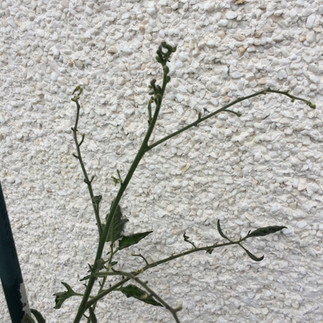Aminopyralid: the hidden killer in compost
- Tomas
- May 10, 2022
- 3 min read
Updated: Oct 10, 2024
I did not even know Aminopyralid existed until I bought new compost that was certified organic for my new greenhouse last year 2021. Unfortunately it has been contaminated by this toxin as I later discovered.
Aminopyralid is a selective herbicide used for control of broadleaf weeds, especially thistles and clovers. It is hormonal disruptor toxin as it moves systemically throughout the plant and deregulates plant growth metabolic pathways affecting the growth process of the plant by binding of aminopyralid at receptor sites normally used by the plant’s natural growth hormones.
It is especially concerning for vegetable growers as it can enter the food chain via manure, which contains long lasting residues. Contaminated manure and compost will affects potatoes, tomatoes, and beans, salads, causing deformation to plants and poor crop.
1. Signs of contamination
If your compost is contaminated you will see the signs on the plant growth or shall I say non-growth and the damage it has caused. The deformation is unlike you ever seen before, the plant will be unable to produce healthy foliage that is required for proper photosynthesis and growth will be stunned. Below you can see my tomatoes affected by aminopyralid contaminated compost.
2. Source of contamination
It is increasingly harder to avoid contaminated compost as many commercial products are reported to be contaminated. To make matters worse even some certified organic composts can be contaminated which is what happed to me. The best way to avoid bringing in contaminated compost is to simply to make your own. If you need to buy from trusted source.
But you can also bring the toxin into your garden through your own compost if you use hay that has been treated with the herbicide or manure from stock that has been fed by contaminated hay.
3. Solution

Test your new compost by sowing broad beans, they will quickly germinate and show you presence of the toxin. If you see signs of contamination contact the seller and manufacturer. In my own case I received test report on weed killer contamination but the detection rate was much to weak for Aminopyralid (mg/kg- part per million) vs Round Up (μg/kg part per billion). I have raised the detection rate discrepancy and suggested stronger detection for aminopyralids but so far haven`t received any reply. Just because it was not detected, which it is easily explained by weak detection rate it does not mean the toxin is not present or potent as you can see from my tomato plants.
If you are somewhat lucky in that the toxin was detected by official test you can ask for reimbursement.
But what if you are stuck with contaminated compost or you have already spread it? Well there are some good news. The aminopyralid seems to be broken down by soil bacteria. So mix the compost with soil that is full of living organisms and let it do it`s thing for few months. If your soil is healthy it will generally have better capacity to bind and degrade toxins although some might be never removed.
Most important is to report it. Unfortunately most of the contamination goes undetected as many growers and gardeners are not aware of this issue and might think the plants are just sick or they did something wrong if they are new to growing. Even some of the more experienced growers might not be informed enough so spreading the word will help too.
I would end up with following food for thought: Every commercial chemical that has been found harmful, toxic, carcinogenic or genotoxic (damage to DNA) and banned from the market has been deemed safe at the time of approval and usage.... I think it`s time to change the way we treat nature and by extension us humans too, as we are part of the nature not separate.
Hopefully you will never experience the effects of this toxin in your garden, but if you do I hope this article will somewhat help you.
Happy gardening












Great article, thanks! Unfortunately my allotment was contaminated with this toxic poison back in 2021 and I'm still dealing with the fallout today. It's mind boggling to think that this product continues to be sold and used when it inevitably finds it's way into our healthy, well cared for soil via expensive bags of "organic blend" manure and compost.
In my case the producer of the bags of manure think the source of the contamination was the spent mushroom compost that they add to the manure to replace peat. They test the manure but not the additives and what is most disappointing is that I clearly wasn't the first, the same company sold contaminated grow bags back in 2015 an…